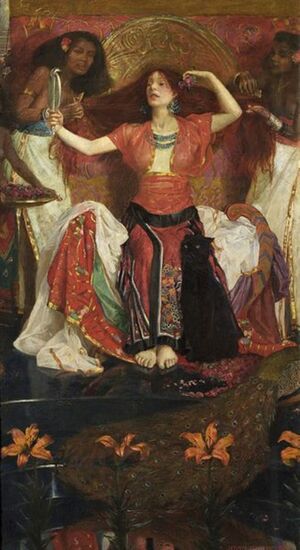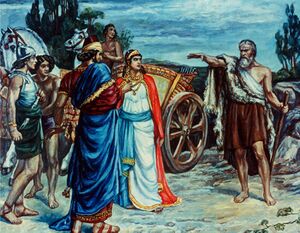إيزابل
| Jezebel | |
|---|---|
| Queen consort of Northern Israel | |
 19th-century painting by John Liston Byam Shaw | |
| توفي | ح. 852 BC Tel Jezreel |
| الزوج | King Ahab |
| الأنجال | Ahaziah, Jehoram, and Athaliah |
| الأب | Ithobaal I |
| الديانة | Baalism |
Jezebel ( /ˈdʒɛzəbəl,_ʔbɛl/;[1][2][3] بالعبرية: אִיזֶבֶל، بالعبرية المعاصرة ʾĪzével بالطبرية ʾĪzeḇel) was the daughter of Ithobaal I of Tyre and the wife of Ahab, King of Israel, according to the Book of Kings of the Hebrew Bible (1 Kings 16:31).[4]
According to the biblical narrative, Jezebel, along with her husband, instituted the worship of Baal and Asherah on a national scale. In addition, she violently purged the prophets of Yahweh from Israel, damaging the reputation of the Omride dynasty.[5][6][7][8] For these offences, the Omride dynasty was annihilated, with Jezebel herself suffering death by defenestration.
Later, in the Book of Revelation, Jezebel is symbolically associated with false prophets.[9]
Meaning of name
Jezebel is the Anglicized transliteration of the Hebrew אִיזֶבֶל ʾĪzeḇel. The Oxford Guide to People & Places of the Bible states that the name is "best understood as meaning 'Where is the Prince?'" (אֵיזֶה בַּעַל ’ēyze ba’al), a ritual cry from worship ceremonies in honor of Baal during periods of the year when the god was considered to be in the underworld.[10] Alternatively, a feminine Punic name noted by the Corpus Inscriptionum Semiticarum, 𐤁𐤏𐤋𐤀𐤆𐤁𐤋 b‘l’zbl,[11] may have been a cognate to the original form of the name, as the Israelites were known to often alter personal names which invoked the names of foreign gods (cf. instances for Baal, Mephibosheth and Ish-bosheth).
Biblical account

Jezebel is introduced into the biblical narrative as a Phoenician princess, the daughter of Ithobaal I, king of Tyre (1 Kings 16:31 says she was "Sidonian", which is a biblical term for Phoenicians in general).[10] According to genealogies given in Josephus and other classical sources, she was the great-aunt of Dido, Queen of Carthage.[10] As the daughter of Ithobaal I, she was also the sister of Baal-Eser II. Jezebel eventually married King Ahab of Samaria, the northern kingdom of Israel.
Near Eastern scholar Charles R. Krahmalkov proposed that Psalm 45 records the wedding ceremony of Ahab and Jezebel,[12] but other scholars cast doubt on this association.[13] This marriage was the culmination of the friendly relations existing between Israel and Phoenicia during Omri's reign, and possibly cemented important political designs of Ahab. Jezebel, like the foreign wives of Solomon, required facilities for carrying on her form of worship, so Ahab made a Baalist altar in the house of Baal, which he had built in Samaria.[14] Geoffrey Bromiley points out that it was Phoenician practice to install a royal woman as a priestess of Astarte, thus she would have a more active role in temple and palace relations than was customary in the Hebrew monarchy.[15]
Elijah

Her coronation as queen upset the balance of power between Yahwism and Baalism.[16][17] As a worshiper of Baal, Jezebel had significant power and influence, which she used to both support Baal's cultus and eliminate its rivals, using methods that the Bible describes in brutal terms.[18][19][20] Obadiah, a pro-Yahwist figure in Ahab's royal court, secretly protected the survivors of these purges in a cave.[14][19]
As a result, Elijah invited Jezebel's prophets of Baal and Asherah to a challenge at Mount Carmel.[19][21] The challenge was to see which god, Yahweh or Baal, would burn a bull sacrifice on an altar. Jezebel's prophets failed to summon Baal in burning the bull sacrifice, despite their cries and cutting themselves. Elijah, however, succeeded when he summoned Yahweh, impressing the Israelites. He then ordered the people to seize and kill the prophets of Baal and Asherah at the Kishon River. After the prophets were slain, Jezebel swore to have Elijah become like her prophets (i.e. killed), even if it meant embracing divine judgement upon herself if she failed to do so.[22][19][21] Elijah fled for his life to the wilderness, where he mourned the devotion of Israel to Baal and lamented being the only Yahwist worshiper left.[14][23]
Naboth
After an unspecified amount of time had passed, since Ahab was notably rebuked by an unnamed prophet for letting Ben-Hadad survive (Ben-Hadad planned to capture Ahab's "wives", including Jezebel, as plunder after besieging Samaria),[24] he visited Naboth's residence. The residence was located near the royal palace in the city of Jezreel. Wishing to acquire Naboth's vineyard so that he could expand his own gardens, Ahab asked to purchase Naboth's vineyard in exchange for a better quality vineyard or financial compensation. Naboth declined, which he justified by informing Ahab that his vineyard was ancestral property. Ahab returned to his palace, sullen and depressed by Naboth's response. Jezebel decided to console him by arranging for Naboth to be entrapped and later executed on the (false) charges of blasphemy against God and the king. After Naboth was executed outside the city, his corpse was licked by stray dogs. Jezebel then informed Ahab that he could seize Naboth's vineyard.
Elijah condemned Ahab for committing theft and murder. As punishment, God decreed Ahab's death and the annihilation of his royal line. Jezebel's death was also decreed, with her corpse to be devoured by dogs.[25]
Death

Three years later, Ahab died in battle. His son Ahaziah inherited the throne, but died as the result of an accident and Ahaziah was succeeded by his brother, Joram. Elisha, Elijah's successor, commanded one of his disciples to anoint Jehu, commander of Joram's army, as king, to be the agent of divine punishment against Ahab's family.[10] Jehu killed Joram, and his nephew Ahaziah (the king of Judah and son of Athaliah, who was possibly the daughter of Jezebel). He later approached the royal palace in Jezreel to confront Jezebel.
Knowing that Jehu was coming, Jezebel put on make-up and a formal wig with adornments and looked out of a window, taunting him. Bromiley says that it should be looked at less as an attempt at seduction than the public appearance of the queen mother, invested with the authority of the royal house and cult, confronting a rebellious commander.[15] In his two-volume Guide to the Bible (1967 and 1969), Isaac Asimov describes Jezebel's last act: dressing in all her finery, make-up, and jewelry, as deliberately symbolic, indicating her dignity, royal status, and determination to go out of this life as a queen.[26]
Jehu later ordered Jezebel's eunuch servants to throw her from the window. Her blood splattered on the wall and horses, and Jehu's horse trampled her corpse. He entered the palace where, after he ate and drank, he ordered Jezebel's body to be taken for burial. His servants discovered only her skull, her feet, and the palms of her hands—her flesh had been eaten by stray dogs, just as the prophet Elijah had prophesied.[27][28] Edwin R. Thiele dates Jezebel's death around 850 BCE.[29]
Historicity

According to Israel Finkelstein, the marriage of King Ahab to the daughter of the ruler of the Phoenician empire was a sign of the power and prestige of Ahab and the northern Kingdom of Israel. He termed it a "brilliant stroke of international diplomacy".[30] He says that the inconsistencies and anachronisms in the biblical stories of Jezebel and Ahab mean that they must be considered "more of a historical novel than an accurate historical chronicle".[30] Among these inconsistencies, 1 Kings 20 states that "Ben-Hadad king of Aram" invaded Samaria during Ahab's reign, but this event did not take place until later in the history of Israel.[31] The two books of Kings are part of the Deuteronomistic history, compiled more than two hundred years after the death of Jezebel. Finkelstein states that these accounts are "obviously influenced by the theology of the seventh century BCE writers".[30] The compilers of the biblical accounts of Jezebel and her family were writing in the southern kingdom of Judah centuries after the events and from a perspective of strict monolatry. These writers considered the polytheism of the members of the Omride dynasty to be sinful. In addition, they were hostile to the northern kingdom and its history, as its center of Samaria was a rival to Jerusalem.[30] According to Dr J. Bimson, of Trinity College, Bristol 1 and 2 Kings are not "a straightforward history but a history which contains its own theological commentary". He points to verses like 1 Kings 14:19 that show the author of Kings was drawing on other earlier sources.[32]
A seal from the 9th century BCE, discovered in 1964, has a partially damaged inscription of "YZBL" which could have once read, "belonging to Jezebel". However, there are some issues with this theory. Whereas on the seal it appears the inscription begins with the letter yodh, Jezebel's name starts with an aleph, which is lacking on the seal; furthermore, the possessive lamedh which would translate to the predicate "belonging to ..." is also missing from the seal. However, it is entirely possible these letters simply could have been located where the seal is now damaged. The seal includes motifs associated with both Egyptian and Israelite royalty, such as the Uraeus cobra which is commonly found on pharaonic artifacts, and symbols such as the winged sun and Ankh, which are found on numerous other Israelite royal seals from the 8th century BCE and onwards. Regardless, scholars do not agree on whether the seal is evidence for the historicity of the biblical character. Some scholars have said that the size and intricacy of the seal could mean it was used by royalty.[33]
Cultural symbol
According to Geoffrey Bromiley, the depiction of Jezebel as "the incarnation of Canaanite cultic and political practices, detested by Israelite prophets and loyalists, has given her a literary life far beyond the existence of a ninth-century Tyrian princess."[15]
Through the centuries, the name Jezebel came to be associated with false prophets. By the early 20th century, it was also associated with fallen or abandoned women.[34] In Christian lore, a comparison to Jezebel suggested that a person was a pagan or an apostate masquerading as a servant of God. By manipulation and seduction, she misled the saints of God into sins of idolatry and sexual immorality.[35] In particular, Christians associated Jezebel with promiscuity. The cosmetics which Jezebel applied before her death also led some Christians to associate makeup with vice. In the Middle Ages, the chronicler Matthew Paris criticised Isabella of Angoulême, the queen consort of John, King of England, by writing that she was "more Jezebel than Isabel".[36] In modern usage, the name of Jezebel is sometimes used as a synonym for sexually promiscuous or controlling women.[37] The Jezebel stereotype is an oppressive image and was used as a justification for sexual assault and sexual servitude during the eras of colonization and slavery in the United States.[38][39][40]
In feminist interpretations and Bible scholarship, Jezebel is re-examined and, for example, seen as unfairly framed (McKinlay, cited in Bellis) or her story falsified (Beach) or as a resource for womanist theology (Lomax).
In popular culture

- The American gospel vocal group Golden Gate Quartet released a single called "Jezebel" in 1941 which narrates the story of Jezebel.[41][42]
- Frankie Laine recorded "Jezebel" (1951), written by Wayne Shanklin, which became a hit song.[43] The song begins:
If ever the Devil was born without a pair of horns
It was you, Jezebel, it was you
If ever an angel fell
Jezebel, it was you, Jezebel, it was you![44] - Iron & Wine included a song "Jezebel" on his 2005 EP Woman King. It contains many references to the biblical Jezebel, in particular the dogs associated with her death.[45]
- Paulette Goddard starred as Jezebel in the film Sins of Jezebel (1953).[46]
- The popular historian Lesley Hazleton wrote a revisionist account, Jezebel: The Untold Story of the Bible's Harlot Queen (2004), presenting Jezebel as a sophisticated queen engaged in mortal combat with the fundamentalist prophet Elijah.[47]
- The Jezabels is an Australian indie rock band founded in 2007. The band's name is based on the biblical character, whom one band member describes as "misunderstood or misrepresented" and "an example of how women are really wrongly presented".[48][49]
- Ronnie Wood and Rod Stewart's song "Stay with Me" includes the line, "I hear you're a mean old Jezebel".
In fiction
- Beach, Eleanor Ferris. The Jezebel Letters: religion and politics in ninth-century Israel. Fortress Press, 2005.
- Bellis, Alice Ogden. Helpmates, harlots, and heroes: Women's stories in the Hebrew Bible. Westminster John Knox Press, 2007.
- Everhart, Janet S. "Jezebel: Framed by eunuchs?." The Catholic Biblical Quarterly 72, no. 4 (2010): 688-698.
- Garrett, Ginger. "Reign: The Chronicles of Queen Jezebel", Book #3 in the Lost Loves of the Bible Series (2013), ISBN 143-4-7659-62
- Hazleton, Lesley. "Jezebel: The Untold Story of the Bible's Harlot Queen" (2009)
- Jackson, Melissa. "Reading Jezebel from the “other” side: Feminist critique, postcolonialism, and comedy." Review & Expositor 112, no. 2 (2015): 239-255.
- Lomax, Tamura. Jezebel unhinged: Loosing the Black female body in religion and culture. Duke University Press, 2018.
- Mokoena, Lerato. "Reclaiming Jezebel and Mrs Job: Challenging Sexist Cultural Stereotypes and the Curse of Invisibility" in Transgression and transformation: Feminist, postcolonial and queer Biblical interpretation as creative interventions (2021).
- Quick, Catherine S. "Jezebel's last laugh: the rhetoric of wicked women." Women and Language 16, no. 1 (1993): 44-49.
- Snyder, J.B., 2012. Jezebel and her Interpreters. Women’s Bible Commentary: Twentieth–Anniversary Edition. Louisville, KY, pp.180-183.
- Wyatt, Stephanie. "Jezebel, Elijah, and the widow of Zarephath: A ménage à trois that estranges the holy and makes the holy the strange." Journal for the Study of the Old Testament 36, no. 4 (2012): 435-458.
References
- ^ Oxford English Dictionary (Second ed.). 1989. "Jezebel" (US) and "Jezebel". Oxford Dictionaries UK English Dictionary. Oxford University Press. Archived from the original on 5 مايو 2019.
- ^ "Jezebel". Collins English Dictionary. HarperCollins. Retrieved 5 مايو 2019.
- ^ قالب:Cite Merriam-Webster
- ^ Elizabeth Knowles, "Jezebel", The Oxford Dictionary of Phrase and Fable, OUP 2006
- ^ "Micah 6:16".
- ^ "2 Chronicles 21:6".
- ^ "2 Kings 8:18".
- ^ ISHDA, T. (1975). "The House of Ahab". Israel Exploration Journal. 25 (2/3): 135–137. JSTOR 27925509.
- ^ B. Duff, Paul (2001). Who Rides the Beast?: Prophetic Rivalry and the Rhetoric of Crisis in the Churches of the Apocalypse. doi:10.1093/019513835X.001.0001. ISBN 978-0-19-513835-1.
- ^ أ ب ت ث Hackett, Jo Ann (2004). Metzger, Bruce M; Coogan, Michael D (eds.). The Oxford Guide to People & Places of the Bible. Oxford University Press. pp. 150–151. ISBN 978-0-19-517610-0.
- ^ Corpus Inscriptionum Semiticarum I. 1926. p. 209.
- ^ Krahmalkov, Charles R. (2000), A Phoenician-Punic Grammar, page 2[التحقق مطلوب]
- ^ Rogerson, J W; McKay, John William (1977). Psalms 1-50. Cambridge University Press. p. 213. ISBN 978-0-521-29160-6.
- ^ أ ب ت "JEZEBEL - JewishEncyclopedia.com". www.jewishencyclopedia.com.
- ^ أ ب ت Bromiley, Geoffrey W. (28 أغسطس 1979). The International Standard Bible Encyclopedia. Wm. B. Eerdmans Publishing. ISBN 978-0-8028-3782-0 – via Google Books.
- ^ Eakin, Frank E. (1965). "Yahwism and Baalism before the Exile". Journal of Biblical Literature. 84 (4): 407–414. doi:10.2307/3264867. ISSN 0021-9231. JSTOR 3264867.
- ^ Miller, J. M. (1 يناير 1967). "The Fall of the House of Ahab". Vetus Testamentum. 17 (3): 307–324. doi:10.1163/156853367X00042. ISSN 0042-4935.
- ^ Mare, Leonard P. "" Twice as much of your Spirit": Elijah, Elisha, and the Spirit of God." Ekklesiastikos Pharos 91.1 (2009): 72-81.
- ^ أ ب ت ث Bayor, Conrad Kandelmwin. "The Alienation of Jezebel: Reading the Deuteronomic Historian's Portrait of Jezebel in the Contemporary Global Context." (2017).
- ^ 1 Kings 16:32
- ^ أ ب Merecz, Robert J. (n.d.). "Jezebel's Oath (1 Kgs 19,2)". Biblica. 90 (2): 257–259. ISSN 0006-0887. JSTOR 42614902.
- ^ Micah 6:16
- ^ Bromiley, Geoffrey William (2009). The International Standard Bible Encyclopedia. Grand Rapids, Michigan: W. B. Eerdmans. ISBN 978-0-8028-3785-1.
- ^ 1 Kings 20:3–43
- ^ "Jezebel: Bible". Jewish Women's Archive.
- ^ Asimov, Isaac (1988). Asimov's Guide to the Bible: Two Volumes in One, the Old and New Testaments (reprint ed.). Wings. ISBN 978-0-517-34582-5.
- ^ Kings&verse=9:35-36&src=kjv 2 Kings 9:35-36
- ^ See also jwa.org/encyclopedia/article/jezebel-midrash-and-aggadah
- ^ Edwin Thiele, The Mysterious Numbers of the Hebrew Kings, (1st ed.; New York: Macmillan, 1951; 2d ed.; Grand Rapids: Eerdmans, 1965; 3rd ed.; Grand Rapids: Zondervan/Kregel, 1983). ISBN 0-8254-3825-X
- ^ أ ب ت ث Finkelstein, Israel; Silberman, Neil Asher (2001). The Bible Unearthed: Archaeology's New Vision of Ancient Israel and the Origin of Its Sacred Texts. Simon and Schuster. pp. 169–195. ISBN 978-0-684-86912-4.
- ^ Israel Finkelstein; Neil Asher Silberman (6 مارس 2002). The Bible Unearthed: Archaeology's New Vision of Ancient Israel and the Origin of Sacred Texts. Simon and Schuster. p. 176. ISBN 978-0-7432-2338-6.
- ^ IVP New Bible Commentary (21st Century Edition), p. 335
- ^ Korpel, Marjo C. A. (مايو 2008). "Fit for a Queen: Jezebel's Royal Seal". Biblical Archaeology Society. Retrieved 17 نوفمبر 2013.
- ^
 Cook, Stanley Arthur (1911). . In Chisholm, Hugh (ed.). دائرة المعارف البريطانية. Vol. 15 (eleventh ed.). Cambridge University Press. p. 411.
Cook, Stanley Arthur (1911). . In Chisholm, Hugh (ed.). دائرة المعارف البريطانية. Vol. 15 (eleventh ed.). Cambridge University Press. p. 411. {{cite encyclopedia}}: Cite has empty unknown parameter:|coauthors=(help) - ^ The New Testament, Book of Revelation., Ch. 2, vs. 20-23.
- ^ Nicholas Vincent 'John's Jezebel' 1999
- ^ "Meaning #2: "an impudent, shameless, or morally unrestrained woman"". Merriam-webster.com. Retrieved 24 مايو 2012.
- ^ Donovan, Roxanne & Williams, Michelle (2002). "Living at the intersection: The effects of racism and sexism on Black rape survivors" (PDF). Women & Therapy. 25 (3–4): 95–105. doi:10.1300/J015v25n03_07. S2CID 143180295. Retrieved 17 أبريل 2019.
- ^ Buchanan, Nicole T. & Ormerod, Alayne J. (2002). "Racialized sexual harassment in the lives of African American women" (PDF). Women & Therapy. 25 (3–4): 107–124. doi:10.1300/J015v25n03_08. S2CID 144425126. Retrieved 17 أبريل 2019.
- ^ Pilgrim, David. "Jezebel Stereotype". Jim Crow Museum. Ferris State University. Archived from the original on 28 يوليو 2011. Retrieved 29 يوليو 2011.
- ^ Young, Alan (1997). Woke Me Up This Morning: Black Gospel Singers and the Gospel Life. University Press of Mississippi. p. 50. ISBN 0-87805-943-1.
- ^ قالب:AllMusic
- ^ Frankie Laine’s hits in the years 1947-1952.Archived 6 يناير 2009 at the Wayback Machine
- ^ "Jezebel lyrics". Frankie Laine lyrics. Metro Lyrics. Archived from the original on 19 ديسمبر 2016. Retrieved 17 نوفمبر 2013.
{{cite web}}: CS1 maint: unfit URL (link) - ^ Leahey, Andrew (9 أبريل 2012). "Iron & Wine, 'Jezebel'". americansongwriter.com. Retrieved 8 أبريل 2014.
- ^ "At The Imperial: 'Jezebel' Color Spectacle Stars Paulette Goddard In Title Role". The News and Eastern Townships Advocate. 14 يناير 1954. Retrieved 17 نوفمبر 2013.
- ^ "Jezebel: The Untold Story of the Bible's Harlot Queen, by Lesley Hazleton". Kirkus reviews. Retrieved 8 أبريل 2014.
- ^ Cherrie, Chrysta. "The Jezabels". AllMusic. Rovi Corporation. Retrieved 2 ديسمبر 2012.
- ^ Lam, Lana (20 مايو 2009). "The Jezabels". Central Coast Express Advocate. News Limited (News Corporation). p. 35. Archived from the original on 15 يناير 2013. Retrieved 3 ديسمبر 2012.
External links
 Media related to إيزابل at Wikimedia Commons
Media related to إيزابل at Wikimedia Commons
قالب:Book of Revelation خطأ لوا في وحدة:Authority_control على السطر 278: attempt to call field '_showMessage' (a nil value).
- مقالات بالمعرفة تحتاج تمحيص الحقائق from September 2019
- جميع الصفحات التي تحتاج تمحيص حقائق
- مقالات المعرفة المحتوية على معلومات من دائرة المعارف البريطانية طبعة 1911
- CS1 maint: unfit URL
- Short description is different from Wikidata
- Articles with hatnote templates targeting a nonexistent page
- Missing redirects
- Use dmy dates from July 2015
- ملوك إسرائيل القديمة
- ملوك يهودا القديمة
- 840s BC deaths
- 1st-millennium BC executions
- 9th-century BC deaths
- 9th-century BC Phoenician people
- 9th-century BC women
- Ancient princesses
- Biblical murderers
- Biblical murder victims
- Female murder victims
- Female murderers
- Monarchs of the Hebrew Bible
- Idolatry
- Murdered royalty
- Omrides
- People executed by defenestration
- People from Sidon
- Queens consort of Israel and Judah
- Women in the Hebrew Bible
- Year of birth unknown
- Baal
- Massacres in the Bible
- Whore of Babylon
- Phoenicians in the Hebrew Bible
